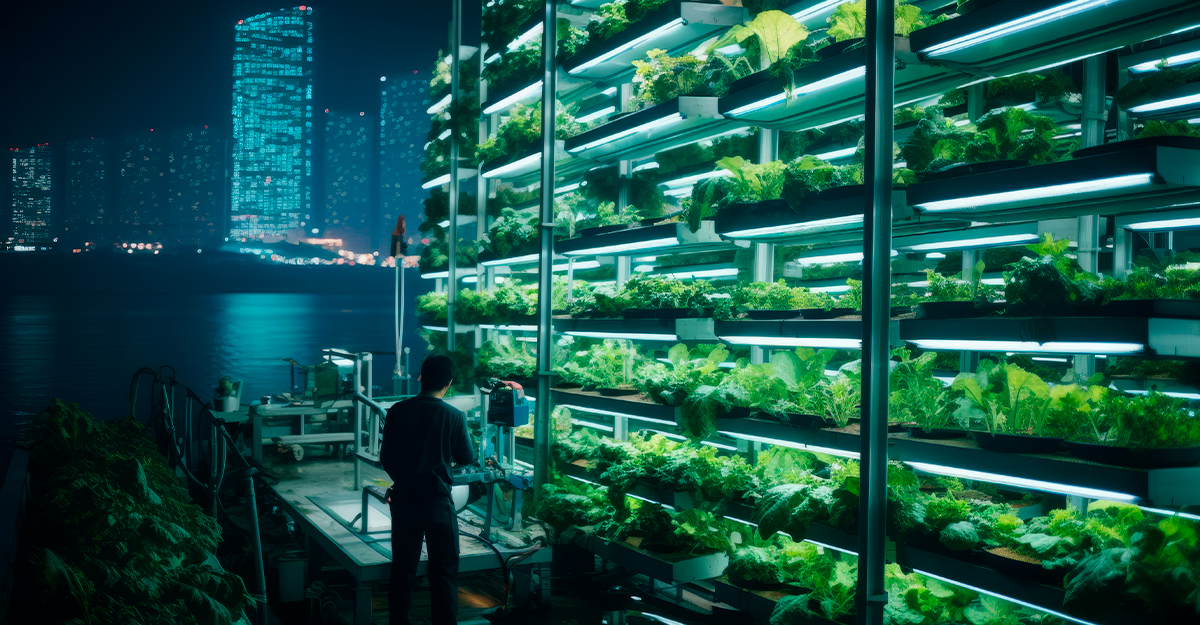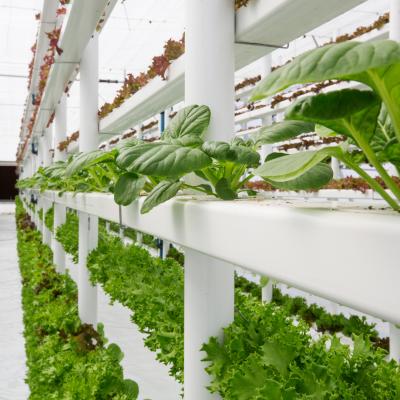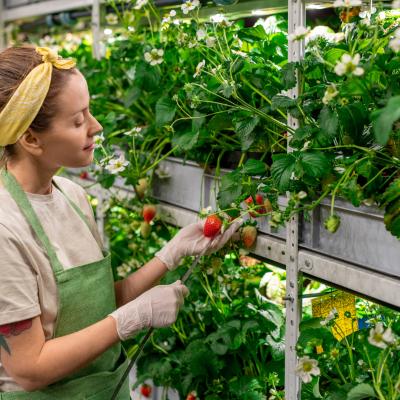Anúncios
Vertical farming emerges as an innovative and sustainable solution to the challenges of food production in urban areas. By leveraging technologies like hydroponics and aeroponics, this practice allows for the cultivation of a wide variety of foods in small spaces, such as rooftops and abandoned buildings. With increasing urbanization and the need to feed growing populations, this approach offers a new path for food production in cities.
In addition to maximizing space usage, vertical farming is an alternative that reduces environmental impact and contributes to food security. Through strict control of growing conditions and efficient use of resources such as water and energy, vertical farms can produce fresh and healthy food year-round. This model not only addresses the challenges of urbanization but also promotes a more sustainable future for cities.
Anúncios
Environmental Benefits of Vertical Farming
Vertical farming stands out primarily for its sustainability. By using systems like hydroponics and aeroponics, it drastically reduces water consumption, a scarce resource in many urban areas. With water reuse and the elimination of soil, the environmental impact is minimized, making food production more efficient and less polluting.
Another important aspect is the reduction of the carbon footprint. By growing food locally, vertical farms reduce the need for long-distance transportation, which lowers greenhouse gas emissions. Additionally, the implementation of renewable energy, such as solar or wind power, can make operations even more eco-friendly and self-sustaining.
Using underutilized urban spaces, such as rooftops and warehouses, for vertical farming also helps revitalize urban areas. These spaces can be transformed into productive hubs that benefit both the local community and the environment, contributing to the improvement of the quality of life in cities.
Finally, vertical farming can act as a model for adapting to climate change. By being carried out in controlled environments, it allows for food cultivation regardless of external climate variations, increasing the resilience of cities in the face of extreme weather events.
Challenges and Limitations of Vertical Farming

While promising, vertical farming still faces significant challenges. One of the main obstacles is the initial implementation cost, which can be high due to the need for advanced infrastructure, such as artificial lighting systems, climate control, and specialized irrigation. These investments can be difficult to overcome, especially for small farmers or urban entrepreneurs.
Additionally, adapting to different types of crops in vertical systems still presents limitations. Large-scale crops, such as cereals and root vegetables, are harder to grow in these systems, which are more suited to leafy greens, herbs, and microgreens. This limits the diversity of food produced, which can be a concern regarding long-term food security.
Dependence on technology can also be seen as a downside. Automated systems and advanced sensors are essential for the success of vertical farming, but they also require constant maintenance and technical knowledge. This can be a barrier to large-scale adoption, especially in areas with limited infrastructure.
Social and cultural acceptance can also be a challenge. Many people are still accustomed to traditional agricultural methods and may have concerns about the quality and safety of food produced in enclosed and controlled environments. Overcoming these cultural barriers will be essential to ensure the expansion of this practice.
How Vertical Farming Works in Urban Environments
Vertical farming is an innovative agricultural practice that uses vertically stacked layers to grow plants in controlled environments, often in urban areas. This method takes advantage of advanced technologies and sustainable practices to maximize food production while minimizing land and resource use. By employing techniques like hydroponics, aeroponics, and aquaponics, vertical farms can produce a wide variety of crops year-round, regardless of external weather conditions. This adaptability makes vertical farming a promising solution to the challenges posed by urbanization and climate change.
In urban environments, vertical farms can be integrated into existing buildings, rooftops, or even repurposed warehouses, transforming underused spaces into productive agricultural sites. The use of artificial lighting, climate control systems, and automated monitoring allows for precise control over growing conditions, resulting in higher yields and reduced dependence on pesticides and fertilizers. As cities continue to grow and the demand for fresh, local food increases, vertical farming presents a viable alternative to traditional farming methods that often require extensive land and water resources.
Advantages of Vertical Farming and the Future of Urban Food Production

One of the main advantages of vertical farming is its ability to produce food close to urban populations. This reduces the carbon footprint associated with transporting food from rural farms to city residents. By growing food locally, vertical farms can provide fresh products harvested at their optimal ripeness, improving taste and nutritional value. Additionally, reducing transportation needs contributes to lower greenhouse gas emissions, making vertical farming a more sustainable option for urban food production.
Another significant benefit of vertical farming is its efficient use of resources. Traditional agriculture often relies heavily on water, but vertical farming systems can use hydroponics or aeroponics to drastically reduce water consumption. These recyclable systems minimize waste and ensure that plants receive the necessary nutrients without excess runoff that can lead to environmental degradation. Furthermore, vertical farms can be designed to use renewable energy sources, such as solar or wind power, further reducing their environmental impact.
Vertical farming also offers the potential for year-round crop production, regardless of seasonal changes. This continuous production cycle not only ensures a consistent supply of fresh food but also allows for the cultivation of a diverse range of crops. Urban farmers can experiment with different varieties and cultivation techniques, leading to increased biodiversity and resilience in food systems. This adaptability is particularly important in the face of climate change, as it allows cities to respond to changing agricultural conditions and food security challenges.
Finally, vertical farming can promote community engagement and education around food production. Many vertical farms incorporate educational programs, workshops, and volunteering opportunities that connect urban residents to the food-growing process. By raising awareness about sustainable practices and the importance of local food systems, vertical farming can inspire a new generation of environmentally conscious citizens who care about the health of their communities and the planet.
How to Implement Vertical Farming Solutions in Your City
Implementing vertical farming solutions in urban areas requires a strategic approach that considers local resources, community needs, and technological advances. Here are some key strategies for successfully integrating vertical farming into your city:
- Use Hydroponic Systems for Efficient Growth: Hydroponics allows plants to grow without soil, using nutrient-rich water. This method is particularly suitable for urban environments where space is limited, as it can be implemented in compact systems that maximize vertical space.
- Incorporate Smart Farming Solutions for Better Management: The use of technology, such as sensors and data analysis, can enhance the efficiency of vertical farming operations. Smart farming solutions enable farmers to monitor plant health, optimize growing conditions, and reduce resource consumption through data-driven decisions.
- Design Vertical Gardens to Maximize Space: Creative design is essential for the success of vertical farming. Utilizing walls, rooftops, and even indoor spaces can help maximize available square footage. Vertical gardens can also enhance the aesthetic appeal of urban areas while providing functional food production.
- Focus on Climate-Resilient Crops for Sustainability: Selecting crops that are well-suited for vertical farming and resilient to climate variability is crucial. By prioritizing climate-resilient varieties, urban farmers can ensure consistent yields and reduce vulnerability to environmental changes.
- Increase Urban Food Security through Local Production: Vertical farming can play a vital role in improving food security in urban areas. By producing food locally, cities can reduce their dependence on external food sources and provide fresh products to underserved communities.
- Promote Community Engagement in Urban Agriculture: Building community support for vertical farming initiatives is essential for their success. Engaging residents through educational programs, volunteer opportunities, and local partnerships can foster a sense of ownership and investment in urban agriculture.
By implementing these strategies, cities can create a thriving ecosystem for vertical farming that benefits residents, the environment, and the local economy. Integrating vertical farming into urban landscapes not only addresses food production challenges but also enhances quality of life in cities.
Did You Enjoy Learning About Vertical Farming and the Future of Urban Food Production?
Vertical farming represents a transformative approach to urban food production that holds immense potential for the future. By harnessing innovative technologies and sustainable practices, cities can create resilient food systems that meet the challenges of urbanization and climate change. The benefits of vertical farming go beyond food production, promoting community engagement and encouraging environmental responsibility.
As we continue to explore the possibilities of vertical farming, it’s clear that this approach can play a crucial role in shaping the future of urban agriculture. If you found this topic intriguing, consider diving deeper into the world of vertical farming and discover how it can contribute to healthier and more sustainable cities.
Frequently Asked Questions
What is vertical farming?
Vertical farming is the cultivation of plants in stacked layers. It is a way to use less space in urban areas.
How can vertical farming help urban food production?
It uses modern technologies, such as LED lights and hydroponics, to grow fresh food in cities. This means more food and less transportation.
What are the benefits of vertical farming and the future of urban food production?
It saves water, requires less land, and reduces the carbon footprint. It’s a smart way to produce food.
Is it possible to grow all types of food in vertical farming?
Not exactly. Greens and herbs do better. However, with innovations, other foods are being tested.
Is vertical farming expensive?
Initial costs can be high, but long-term efficiency can make it worthwhile. In the coming years, it could become more affordable.
